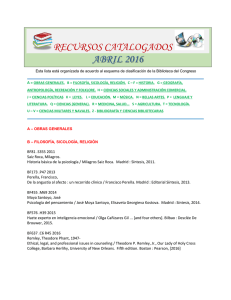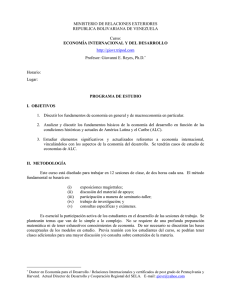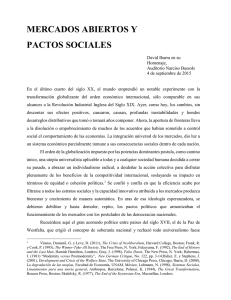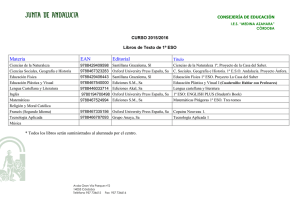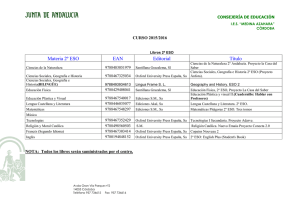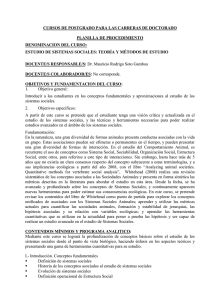en otra ventana
Anuncio
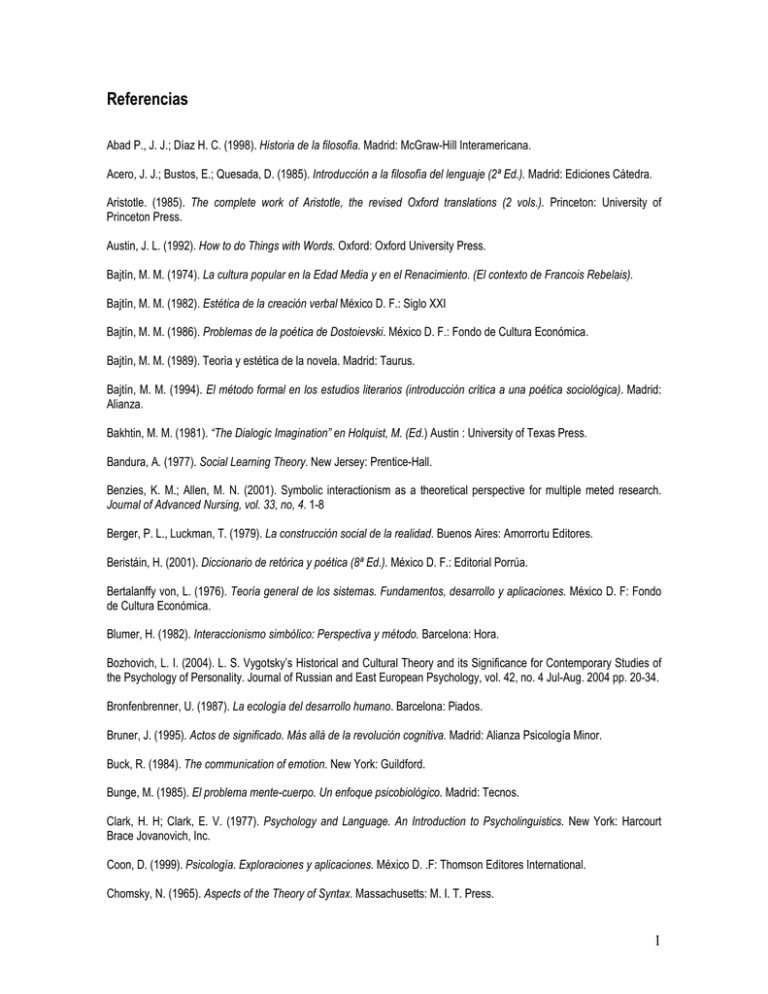
Referencias Abad P., J. J.; Díaz H. C. (1998). Historia de la filosofía. Madrid: McGraw-Hill Interamericana. Acero, J. J.; Bustos, E.; Quesada, D. (1985). Introducción a la filosofía del lenguaje (2ª Ed.). Madrid: Ediciones Cátedra. Aristotle. (1985). The complete work of Aristotle, the revised Oxford translations (2 vols.). Princeton: University of Princeton Press. Austin, J. L. (1992). How to do Things with Words. Oxford: Oxford University Press. Bajtín, M. M. (1974). La cultura popular en la Edad Media y en el Renacimiento. (El contexto de Francois Rebelais). Bajtín, M. M. (1982). Estética de la creación verbal México D. F.: Siglo XXI Bajtín, M. M. (1986). Problemas de la poética de Dostoievski. México D. F.: Fondo de Cultura Económica. Bajtín, M. M. (1989). Teoría y estética de la novela. Madrid: Taurus. Bajtín, M. M. (1994). El método formal en los estudios literarios (introducción crítica a una poética sociológica). Madrid: Alianza. Bakhtin, M. M. (1981). “The Dialogic Imagination” en Holquist, M. (Ed.) Austin : University of Texas Press. Bandura, A. (1977). Social Learning Theory. New Jersey: Prentice-Hall. Benzies, K. M.; Allen, M. N. (2001). Symbolic interactionism as a theoretical perspective for multiple meted research. Journal of Advanced Nursing, vol. 33, no, 4. 1-8 Berger, P. L., Luckman, T. (1979). La construcción social de la realidad. Buenos Aires: Amorrortu Editores. Beristáin, H. (2001). Diccionario de retórica y poética (8ª Ed.). México D. F.: Editorial Porrúa. Bertalanffy von, L. (1976). Teoría general de los sistemas. Fundamentos, desarrollo y aplicaciones. México D. F: Fondo de Cultura Económica. Blumer, H. (1982). Interaccionismo simbólico: Perspectiva y método. Barcelona: Hora. Bozhovich, L. I. (2004). L. S. Vygotsky’s Historical and Cultural Theory and its Significance for Contemporary Studies of the Psychology of Personality. Journal of Russian and East European Psychology, vol. 42, no. 4 Jul-Aug. 2004 pp. 20-34. Bronfenbrenner, U. (1987). La ecología del desarrollo humano. Barcelona: Piados. Bruner, J. (1995). Actos de significado. Más allá de la revolución cognitiva. Madrid: Alianza Psicología Minor. Buck, R. (1984). The communication of emotion. New York: Guildford. Bunge, M. (1985). El problema mente-cuerpo. Un enfoque psicobiológico. Madrid: Tecnos. Clark, H. H; Clark, E. V. (1977). Psychology and Language. An Introduction to Psycholinguistics. New York: Harcourt Brace Jovanovich, Inc. Coon, D. (1999). Psicología. Exploraciones y aplicaciones. México D. .F: Thomson Editores International. Chomsky, N. (1965). Aspects of the Theory of Syntax. Massachusetts: M. I. T. Press. 1 Chomsky, N. (1966). Cartesian Linguistics. New York: Harper & Row. Chomsky, N. (1968). Language and Mind. New York: Harcourt Brace Jovanovich. Damasio, A. (1999). The feeling of what happens. New York: Harcourt & Brace. Deegan, M. J. (1989). American ritual dramas. Social rules and cultural meanings. New York: Greenwood Press. Denzin, N. K. (1992). Symbolic interactionism and cultural studies. The politics of interpretation. Oxford: Blackwell. Dewey, J. (1982). Naturaleza humana y conducta. Introducción a la psicología social. México D. F.: Fondo de Cultura Económica. Díaz, J. L.; Griffin, D.; Real, L. A.; Mondragón-Ceballos, R.; Nieto, J. Y Cabrera, R. (1994). La mente y el comportamiento animal: Ensayos en etología cognitiva. México D. F.: Fondo de Cultura Económica. Durán, M. A. (2001). Feyerabend. Madrid: Ediciones del Orto. Durkheim, É. (2002). Las reglas del método sociológico. Barcelona: Folio. Eccles, J. C.; Zeier, H. (1985). El cerebro y la mente. Reflexiones biológicas sobre la prehistoria, naturaleza y porvenir del hombre. Barcelona: Herder. Eccles, J. C. (1986). La psique humana. Madrid: Tecnos. Engels, F. (1971). Obras selectas. Moscú: Ediciones en lenguas extranjeras. Feyerabend, P. K. (1981). Tratado contra el método. Madrid: Editorial Tecnos. Forni, P. Las metodologías de George Herbert Mead y Herbert Blumer. Similitudes y diferencias (en línea). Buenos Aires: Instituto de Investigación en Ciencias Sociales (IDICSO), Facultad de Ciencias Sociales, Universidad del Salvador, Noviembre 2003. Accesible en Internet: <http://www.salvador.edu.ar/csoc/idicso> Forrester, J. (1980). El lenguaje y los orígenes del psicoanálisis. México D. F. : Fondo de Cultura Económica. Freud, S. (1981). Obras completas (4ª ed.).3 vols. Madrid: Biblioteca Nueva. Fromm, E. (1990). El arte de amar. México D. F.: Piados. Fromm, E. (1992). El amor a la vida. México D. F.: Piados. Fromm, E. (1993a). Psicoanálisis de la sociedad contemporánea. México D. F.: Fondo de Cultura Económica. Fromm, E. (1993b). Ética y política. México D. F.: Piados. Fromm, E. (1993c). ¿Tener o ser? México D. F.: Fondo de Cultura Económica. García V., L. (1989). Historia de la psicología. Madrid: Eudema. Geertz, C. (1983). Local Knowledge. New York: Basic Books, Inc., Publishers. Geertz, C. (1988). La interpretación de las culturas. Barcelona: Gedisa. Gergen, K. J. (1996). “La construcción social: emergencia y potencial,” en Pakman, Marcelo (Comp.). Construcciones de la experiencia humana, vol 1. Barcelona: Gedisa. 2 Glaserfeld von, E. (1996). “Aspectos del constructivismo radical,” en Pakman, Marcelo (Comp.). Construcciones de la experiencia humana, vol 1. Barcelona: Gedisa. Godino, J. D.; Llinares, S. (2000). El interaccionismo simbólico en educación matemática. Educación Matemática, vol. 12, no. 1: 70-92. Greenfield, P. M.; Smith, J. H. (1976). The Structure of Comunication in Early Language Development. New York: Academic Press. Greenwood, J. D. (1999). From ‘Völkerpsychologie’ to cultural psychology: the once and future discipline? Philosophical Psychology, vol. 12, no. 4 p. 503-514. Grice, H. P. (1989). Studies in the Way of Words. Cambridge, Mass.: Harvard University Press. Haro de, A. (1983). Introducción a la etología. Barcelona: Omega. Hernández S., R.; Fernández C., C.; Baptista L., P. (2003). Metodología de la investigación (3ª Ed.). México D. F.: MacGraw-Hill Interamericana Editores. Jakobson, R. O. (1960). “Linguistics and Poetics” en T. A. Sebeok, ed. Style in Language. Cambridge, Mass.: M.I.T. Press. James, W. (1992). Writings 1878-1899. New York: The Library of America. James, W. (2002). Pragmatismo: un nuevo nombre para algunos antiguos modos de pensar. Barcelona: Ediciones Folio. Jung, C. G. (1972). Teoría del psicoanálisis. Barcelona: Plaza & Janés. Kozulin, A. (1994). La psicología de Vygotski. Madrid: Alianza. Krippendorff, K. (1997). “Principales metáforas de la comunicación y algunas reflexiones constructivistas acerca de su utilización,” en Pakman, Marcelo (Comp.). Construcciones de la experiencia humana, vol 2. Barcelona: Gedisa. Kuhn, T. S. (1970). The Structure of Scientific Revolutions. (2ª ed.) Chicago: University of Chicago Press. Leontiev, A. N. (1978). Activity, Consciousness, and Personality. Englewood Cliffs, N. J.: Prentice-Hall. Levy, L. H. (1975). Interpretación psicológica. México D. F.: Fondo de Cultura Económica. Lewinson, S. C. (1989). Pragmática. Barcelona : Teide. Liebert, R. M.; Spiegler, M. D. (2000). Personalidad. Estrategias y temas (8ª Ed.). México D. F.: International Thomson Editores. Lorenz, K. (1986). Fundamentos de la etología. Estudio comparado de las conductas. Barcelona: Piados. Lauer, R. H.; Handel, W. H. (1977). Social psychology: The theory and application of symbolic interactionism. Boston: Houghton Mifflin Company. Luria, A. R. (1980). Lenguaje y pensamiento. Barcelona: Fontanella. Magnusson, D. (1989). Personality Research: Challenges for the Future. European Journal of Psychology, 4, 1-17. Martínez S., A. (1999). Ricoeur. Madrid: Ediciones del Orto. 3 Maturana, H. (1995). La realidad: ¿objetiva o construida? I. Fundamentos biológicos de la realidad. Barcelona: Editorial Anthropos. Maturana, H. (1995b). La realidad: ¿objetiva o construida? II. Fundamentos biológicos de la realidad. Barcelona: Editorial Anthropos. Maturana, H. (2001). Emociones y Lenguaje en educación y política. (10ª ed.) Santiago, Chile: Dolmen Ediciones. Maturana, H.; Varela, F. (1996). El árbol del conocimiento. Las bases biológicas del conocimiento. Madrid: Editorial Debate. Martín, G.; Pear, J. (1999). Modificación de conducta. Qué es y cómo aplicarla (5ª ed.). madrid: Prentice-Hall. Mead, G. H. (1947). Mind, Self and Society. From the Standpoint of a Social Behaviorist. Chicago: The University of Chicago Press. Morris, C. W. (1946). Signs, Language and Behavior. New York: Prentice-Hall, Inc. Morris, C. G. (1987). Psicología. Un nuevo enfoque. (5ª Ed.). México D. F.: Prentice-Hall Hispanoamericana. Moya, C. (1992). “Introducción a la filosofía de Davidson: mente, mundo y acción,” en Davidson, D.: Mente, mundo y acción. Barcelona: Piados. Murray, E. L. (Ed.) (1987). Imagination and phenomenological psychology. Pittsburgh, Pennsylvania: Duquesne University Press. Nagel, T. (1986). The View from Nowhere. New York: Oxford University Press. Ogden, C. K.; Richards, I. A. (1984). El significado del significado. Una investigación acerca de la influencia del lenguaje sobre el pensamiento y de la ciencia simbólica. Barcelona: Ediciones Piados. Pakman, M. (Comp.). (1996). Construcciones de la experiencia humana, vol 1. Barcelona: Gedisa. Pakman, M. (Comp.). (1997). Construcciones de la experiencia humana, vol 2.. Barcelona: Gedisa. Pavlov, I. (1960). Condintioned Reflexes. New York: Dover. Peirce, C. S. (1955). Philosophical Writings of Pierce. New York: Dover Publications, Inc. Peirce, C. S. (1966). Collected Papers of Charles Sanders Pierce, Volumes VII and VIII. Massachusetts: Harvard University Press. Pierce, C. S. (1988). El hombre un signo (el pragmatismo de Pierce). Barcelona: Editorial Crítica. Plutchik, R. (1970). Emotion: A psychoevolutionary analysis. New York: Harper & Row. Popper, K. (1992). En busca de un mundo mejor. Barcelona: Editorial Piadós. Popper, K.; Eccles, J.C. (1977). The self and its brain. New York: Springer. Potter, J. (1998). La representación de la realidad. Discurso, retórica y construcción social. Buenos Aires: Piados. Prieto, J. L. (1991). La utopia skinneriana. Bases psicológicas. México D. F.: Grijalbo. Quine, W. V. O. (1960). Word and Object. Cambridge, Mass.: M. I. T. Press. 4 Quine, W. V. O. (1973). The Roots of Reference. La Salle, Ill. : Open Court Publishing. Reeve, J. (1994). Motivación y emoción. Madrid: McGraw-Hill Interamericana. Rifaterre, M. (1984). Semiotics of Poetry. Indiana: Indiana University Press. Ricoeur, P. (1976). Interpretation Theory: Discourse and the Surplus of Meaning. Forth Worth: Texas Christian University Press. Richards, I. A. (1927). Practical Criticism: a study of literary judgment. London: Kegan Paul. Richards, I. A. (1936). The philosophy of rhetoric. London: Oxford University Press. Richards, I. A. (1976). Fundamentos de crítica literaria. Buenos Aires: Editorial Huemul. Robbins, D. (2001). Vygotsky’s Psychology-Philosophy: A Metaphor for Language Theory and Learning. New York: Kluwer Academic/Plenum Publishers. Rommetveit, R. (1974). On Message Structure: A Framework for the Study of Language and Communication. New York: Wiley. Rorty, R. (1982). Consequences of Pragmatism. Minneapolis: University of Minnesota Press. Ruwet, J. (1975). Etología. Barcelona: Herder. Samovar, L. A.; Porter, R. E.; Jain, N. C. (1981). Understanding intercultural communication. Belmont, CA: Wadsworth Publishing Company. Santrock, J. W. (2001). Psicología de la educación. México D. F.: McGraw-Hill. Sartre, J. P. (1989). El existencialismo es un humanismo. Barcelona : Edhasa. Searle, J. R. (1969). Speech Acts. Cambridge: Cambridge University Press. Searle, J. R. (1994). Mentes, cerebros y ciencia (3ª ed.). Madrid: Ediciones Cátedra. Shotter, J. (1996). “El lenguaje y la construcción del sí mismo,” en Pakman, Marcelo (Comp.). Construcciones de la experiencia humana, vol 1. Barcelona: Gedisa. Smith, W. J. (1982). Etología de la comunicación. México D. F.: Fondo de Cultura Económica. Spirito, U. (1945). El pragmatismo en la filosofía contemporánea. Buenos Aires: Editorial Losada. Swenson, L. C. (1991). Teorías del aprendizaje (2ª Ed.). México D. F.: Editorial Piadós. Taylor, Ch. (1964). The Explanation of Behaviour. London: Routledge & Kegan Paul. Urban, W. M. (1952). Lenguaje y realidad. La filosofía del lenguaje y los principios del simbolismo. México D. F.: Fondo de Cultura Económica. Vygotsky, L. S. (1981). Thought and Language (15ª Ed.). Massachusetts: The M. I. T. Press Weiner, B. (1986). An attributional theory of motivation and emotion. New York: Springer-Verlag. Wertsch, J. V. (1981). The Concept of Activity in Soviet Psychology. Armonk, New York: Sharpe, M. E. 5 Wertsch, J. V. (1988). Vygotsky y la formación social de la mente. Barcelona: Piados. West, D. W. (1999). Lev Vygotsky’s psychology of art and literature. Changing English, vol. 6, no. 2. 47-55 West, D. W. (2001). Psychologies of art and literature: a comparison of the work of I. A. Richards and L. S. Vygotsky. Changing English, vol. 8, no. 1. 17-27 Wittgenstein, L. (1953). Philosophical Investigations. New York: MacMillan. Wittgenstein, L. (1958). The Blue and Brown Books. New York: Harper & Brown. 6

